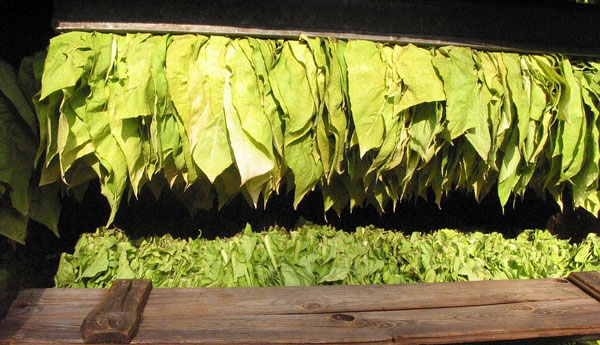
Tobacco and tradition are synonymous in the United States, particularly its southeastern reaches. One of the many crops native exclusively to our shores, tobacco was once widely grown and widely exported, American tobacco being a gold standard among connoisseurs abroad. That said, its wide production stateside has become a shadow of itself; almost a mere memory. Obviously there are plenty of reasons for this. The crop is one of the hardest on the soil, and consumer demand has plummeted amidst a growing number of health concerns and directly antagonistic government initiatives. Despite all this, tobacco’s mystique remains as potent as its connection to our past.
Thanks to the latter, more modern phenomena, I myself have never had much knowledge of the plant, beyond that Sir Walter Raleigh comes in a tin. That changed when I began chatting with a neighbor who had grown up cutting tobacco in the old tobacco belt, a treasure trove of the sorts of knowledge that, once common, have become increasingly rare.
Air Cured
The first types of tobacco found on the market are air-cured tobaccos, which encompass both burly and cigar variants. Air-cured tobaccos are barn-dried for 6-8 weeks in rows hung all the way to the ceiling. The different heights of the leaves on the tobacco stalk correspond with different grades of tobacco (this is also true for flue- and fire-cured): flyings (aka. trash, the lowest and most withered leaves), lugs (second from bottom), leaf (second from top) and tips (the uppermost row). Not all stalks have all five grades, however, some top out at three or so. As the name implies, air-cured tobacco tends to be light and airy, with both high sugar content and high nicotine.
Fire Cured
Next is fire-cured tobacco. These leaves are hung in barns over smoldering fires, for up to ten weeks. The result? Thicker tobaccos like pipe and chewing tobacco. While the nicotine content in such tobaccos remains high, the sugars trend toward the other end of the spectrum.
Flue Cured
Does this sound like fire cured? If so, you’re not far off. As its name implies, flue cured is cured by fire (or in the modern day–heat, simply without the smoke). Flue cured tobacco was traditionally dried in barns with exterior heat boxes (termed oasts), and flues running within. As the heat was slowly increased over the course of a week, it cured the tobacco without ever exposing the leaves to smoke. Nowadays, flue cured tobacco relies heavily on gas-powered heating system, though the principle remains the same.
Sun Cured
Last but not least comes one of the oldest methods on the books. Sun cured tobacco is so rare in the US, I actually had to dig into it a bit myself. A method primarily used in the Mediterranean regions, sun curing tobacco really is as simple as it sounds: leave the leaves out in the hot sun until they are dry and withered. Low in nicotine and sugar, this sort of tobacco is especially fragrant, and is commonly used in pipe tobacco blends for this reason.
Fermented
I hesitate to include this here, as fermented tobacco is actually subjected to a whole extra step rather than simply cured differently, but its hard to say when else I’d discuss it. What this essentially entails is pressurizing cured tobacco (sometimes with sugar, sometimes with steam, and sometimes just with…well…pressure) in a press or with weights for long periods of time. This results in extremely strong, flavorful tobacco.
A humble homesteader based in an undisclosed location, Lars Drecker splits his time between tending his little slice of self-sustaining heaven, and bothering his neighbors to do his work for him. This is mainly the fault of a debilitating predilection for fishing, hunting, camping and all other things outdoors. When not engaged in any of the above activities, you can normally find him broken down on the side of the road, in some piece of junk he just “fixed-up.”

Cecil Ferguson says
Air cured- hang in the barn from top row to bottom row isn’t what makes the different grades. Each stalk has different grades. Sometimes you may have three grades on a stalk others may have up to five grades. I worked tobacco in the 60s and early 70s . It is hard work. That’s how we made a little difference in our way of life.
Rickety Rick says
tes, you are exactly correct. I grew up on a farm that grew tobacco and we would also sell the different leaves to certain people who would want it for, cigs, chew, cigars and even seasoning.
Lars Drecker says
Thank you both for the correction! Sloppy writing on my part. I have updated the text accordingly!